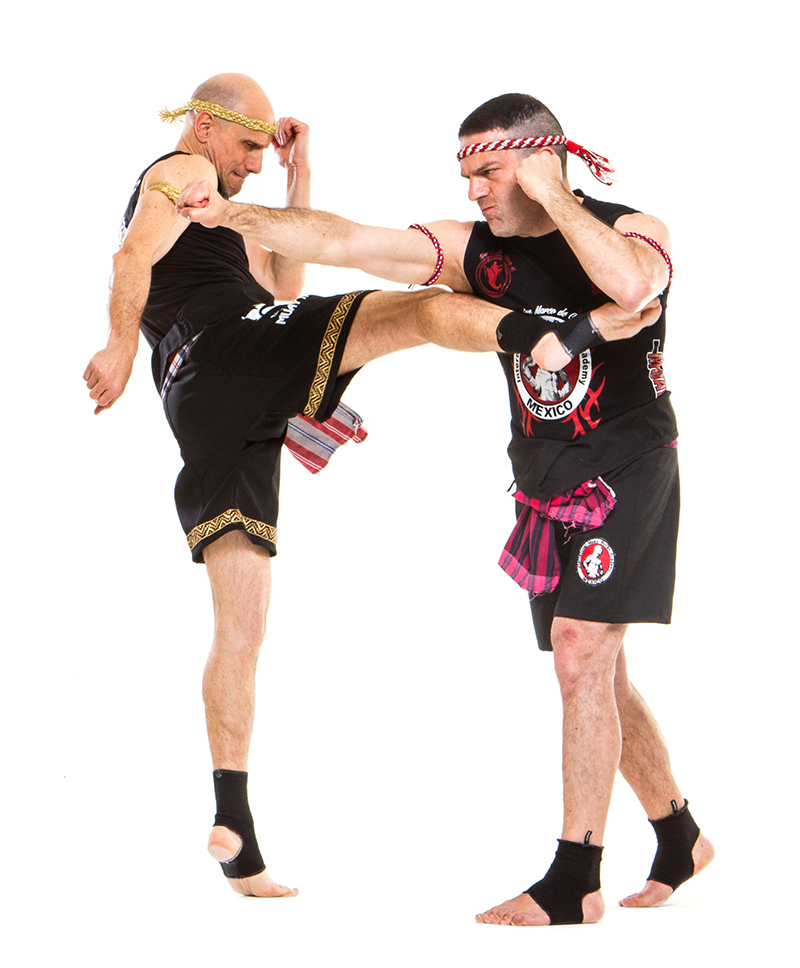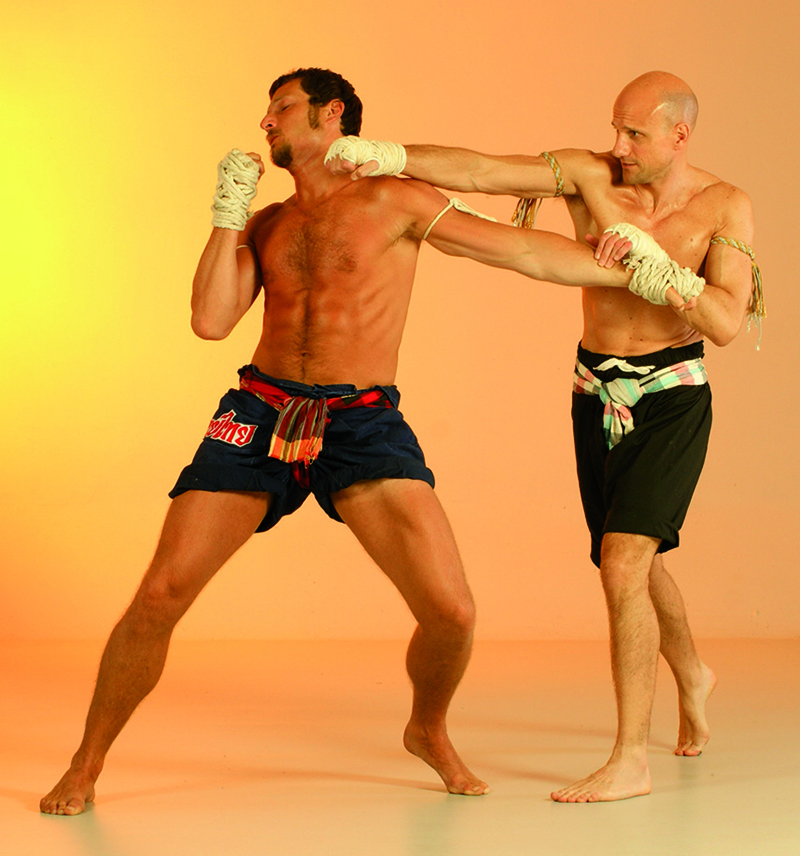
Salab Fan Pla: footwork, counter technique, life style
Muay Thai is the Art of fighting with the main body weapons. Hands, feet, legs, knees, elbows and head are used to skilfully attack and defend in hundreds of effective ways. Muay Thai’s attacking system is renowned worldwide: a thai boxer’s kicks, knee and elbow strikes are considered some of the most powerful strikes a human being can execute. However, the Siamese defensive style is to be ranked among the best in Martial Arts, too. In fact, the thai Art of Defence (Sillapha Kan Rab) is a sophisticated defensive system that, once mastered, is the perfect complement to the devastating offensive maneuvers typical of this ancient combat art. The Mother of all defensive strategies of Muay Thai, the first maneuver taught to all Muay students to keep safe during a fight is called Salab Fan Pla. This strategy realistically applies what the ancient Latins suggested as the golden rule of any fight, that is “primum vivere” ,i.e. survive first. This ancestral Siamese fighting strategy teaches how to apply a swift zig-zag step that resembles the alternating (Salab, สลับ) of the teeth (Fan, ปลา) of a fish (Pla, ปลา). This fundamental maneuver allows you to avoid a frontal collision with any strike the opponent may throw at you. By avoiding your enemy’s power, moving to the outside of the line of fire, you can reach a dominant angle from where strikes, grabs and joint locks can be more easily applied. In fact, thanks to a well-timed sidestep, you actually blend with the offensive action, depriving the attack of all its aggressive force. If your timing is good, you can end up at an angle to the opponent, thus achieving a remarkable tactical advantage over the attacker. First, only one of the latter’s legs and one arm can reach you instead of two. Secondly, the attacks you can execute from an angled position are more difficult to counter than those executed from a face to face position. All this, brings as a consequence that your actions can be performed with relative ease, compared to what would happen if the assailant were facing you. By shifting out of the line of the opponent’s strike and by checking his arm, you are positioned in an ideal manner to reach the vital points located on the side of his head. The counterattacks can be executed with the lead hand or with the rear hand, with the front or back knee, with the front or back elbow. Shin kicks can also be used to attack the legs, back or ribcage, even if a round kick delivered from such a short distance needs very powerful hips’ rotation to be effective.
Proper execution of Salab Fan Pla step.
In all kinds of steps the boxer must train both his advancing and retreating strategies. In sidestepping, balance must be maintained (the center of gravity must be located midway between the boxer’s feet) in order to be able to attack and defend swiftly at any moment, in a fight. Through proper evasive footwork, the Nak Muay will make an opponent miss while best positioning himself in order to deliver strong counter blows from the “outer circle”. An important element of footwork is the coordination of hands and feet; when the feet and hands work together the fighter is perfectly balanced, well protected and ready to attack or defend efficiently.
Many oriental martial arts consider sidestepping a fundamental defensive attitude around which a full combative strategy can be built. In Japanese martial arts such as Karate, Judo or Aikido, Tai Sabaki is the term which relates to body shifting: the shift is usually employed to evade an attack in such manner that the defender ends up in an advantageous position. An example of Tai Sabaki is moving off the line of attack; this implies the use of good timing rather than physical strength. The striking similarities with Siamese Salab Fan Pla fighting strategy need no comment.
Likewise, many great western Boxing champions made full use of the evasive fighting strategy their Thai counterpart call Salab Fan Pla. When I was a young boxer I was taught the evasive step at a very early stage of my apprenticeship: the sidestep was called “the bullfighter’s shift” by my trainer. This name was a clear reference to the elegant evasive tactic of a torero who evades the bull’s charge, in preparation of a deadly stab by his sword. A famous exponent of this kind of technical attitude was James “Peerless” Driscoll. In his books the great champion explained in detail how skillful boxers should use side-stepping as much as possible as a safe and effective way to avoid the opponent’s heavy artillery. “Side-stepping is safe because it spares the inevitable bruises and weariness derived from repeated stopping: a jarred nerve may easily partially or fully paralyse the guarding arm impairing its subsequent utility. Moreover, a block or parry, however skilfully employed, is always a waste of time and energy. If one sidesteps a blow he has always both hands ready to retaliate and the off-balanced opponent will be brought right in to receive a counter strike.”
Examples of combat applications of Salab Fan Pla.
1. Outside step, wrist grab and double counter attack: push elbow and diagonal knee. As the attacker throws a right straight punch, step out and catch his wrist with your rear hand. From a dominant angled position you can counterattack with a powerful combination: a push elbow to the opponent’s elbow joint followed by a diagonal knee strike to the midsection are a very efficient sequence of counterattacks. ( video 1)
2. Outside step, wrist grab and simultaneous elbow and knee counter attack. Against a straight lead punch to the head, step out and parry the attack. At the same time grab the opponent’s wrist and close the gap. From a dominant angle you can strike the face (with a horizontal elbow slash) and the solar plexus (with a straight knee) at the same time. (video 2)
3. Sidestep against a left lead, open hand parry followed by a check of the attacking arm and straight punch to the jaw. As the opponent attacks with a straight lead step out of the line of fire and parry the blow with your front hand. Without losing contact with the attacking arm, counterattack immediately with a straight punch to the side of the head (temple) or jaw of the opponent. (image 1)
The case of Muay Chaisawat.
In Muay Chaisawat, defensive maneuvers are listed according to 3 fundamental systems. In the first system techniques are divided according to the function they have in repelling opponents’ attacks. There are defensive techniques against punch, against kick, against knee, and against elbow. In the second system, techniques are divided according to the defender’s weapon used to counter: counters by punches are included in the first group, counters by kicks are in the second group, counter by knees are in the third group and counters by elbows in the fourth group. The third system divides defensive techniques into 3 groups: all techniques that combine outside stepping with parrying or dodging are included in the first group (Salab Fan Pla group). Techniques that combine inside step and parrying are included in the second group (Paksa Waeg Rang group). Defences by the knees against kicks and knee strikes are included in the third group. According to Master Chaisawat, the strategic applications of Salab Fan Pla are so many and so much important that all together they form a whole counter-fighting system. In fact, at the same time or immediately after sidestepping, a clever fighter always executes a swift counter strike to one of the opponent’s exposed weak spots from a very advantageous position (from the so-called dominant angle). The counters can be one or more punches, one or more kicks, one or more knee strikes or one or more elbow blows: moreover, several throws and joint locking maneuvers are easily applied after Salab Fan Pla step. The huge amount of possible counter techniques that a skilled boxer can execute from a dominant angle form a very efficient method of counter-fighting. Some boxers’ attitude leads them to specialize in evasive footwork combined with hard counter strikes: such boxers make full use of all the possible applications of Salab Fan Pla combat strategy and very often become true champions.
Salab Fan Pla and resilience.
Being skilled in using Salab Fan Pla in everyday life can be compared to possessing the quality of resilience. In fact, resilient people develop a mental capacity that allows them to adapt with ease in the face of adversity, bending like bamboo instead of breaking. A resilient fighter not only uses evasive tactics to avoid head-on collisions with the opponent’s attack but he manages to exploit the change in position to efficiently turn a swift defence into a strong counterattack. The same is true for everyday small wars that we are all destined to face in the course of our lives: step away from adversity but keep an assertive mentality. You want to survive first, that’s for sure, but at the same time you also want to come out a winner. Every new challenge is an occasion to grow stronger mentally and physically: Salab Fan Pla is the winning strategy both in the ring and in real life battles.


